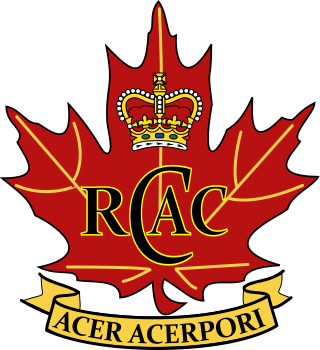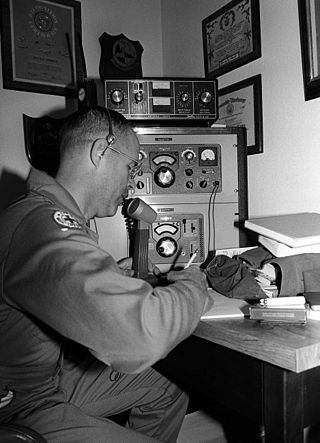
A salute is usually a formal hand gesture or other action used to display respect in military situations. Salutes are primarily associated with the military and law enforcement, but many civilian organizations, such as Girl Guides, Boy Scouts and the Salvation Army use formal salutes. Ordinary civilians also salute informally to greet or acknowledge the presence of another person, such as a tip of the hat or a hand wave to a friend or neighbor.

Military ranks are a system of hierarchical relationships, within armed forces, police, intelligence agencies or other institutions organized along military lines. The military rank system defines dominance, authority, and responsibility in a military hierarchy. It incorporates the principles of exercising power and authority into the military chain of command—the succession of commanders superior to subordinates through which command is exercised. The military chain of command constructs an important component for organized collective action.
Corps is a term used for several different kinds of organization. A military innovation by Napoleon I, the formation was first named as such in 1805. The size of a corps varies greatly, but two to five divisions and anywhere from 40,000 to 80,000 are the numbers stated by the US Department of Defense.

The Canadian Armed Forces are the unified military forces of Canada, including land, sea, and air commands referred to as the Canadian Army, Royal Canadian Navy, and the Royal Canadian Air Force. The CAF also operates several other commands, including the Canadian Forces Intelligence Command, the Canadian Joint Operations Command, and the Canadian Special Operations Forces Command. Personnel may belong to either the Regular Force or the Reserve Force, which has four sub-components: the Primary Reserve, Supplementary Reserve, Cadet Organizations Administration and Training Service, and the Canadian Rangers. Under the National Defence Act, the Canadian Armed Forces are an entity separate and distinct from the Department of National Defence, which also exists as the civilian support system for the forces.

An aide-de-camp is a personal assistant or secretary to a person of high rank, usually a senior military, police or government officer, or to a member of a royal family or a head of state.

The Royal Canadian Legion is a non-profit Canadian veterans' organization founded in 1925. Members include people who served in the military, Royal Canadian Mounted Police, provincial or municipal police, Royal Canadian Air, Army and Sea Cadets and direct relatives.
In military aviation, a wing is a unit of command. In most military aviation services, a wing is a relatively large formation of planes. In Commonwealth countries a wing usually comprises three squadrons, with several wings forming a group. Each squadron will contain around 20 planes.

The Royal Canadian Army Cadets is a national Canadian youth program sponsored by the Canadian Armed Forces and the civilian Army Cadet League of Canada. Under the authority of the National Defence Act, the program is administered by the Canadian Armed Forces and funded through the Department of National Defence. Additionally, the civilian partner of the Royal Canadian Army Cadets, the Army Cadet League of Canada, also ensures financial, accommodations and transportation support for RCAC programs and services at a community level.

British Commonwealth Forces Korea (BCFK) was the formal name of the British Commonwealth army, naval and air units serving with the United Nations (UN) in the Korean War. BCFK included Australian, British, Canadian, Indian, and New Zealand units. Some Commonwealth units and personnel served with United States and/or other UN formations, which were not part of BCFK.

Auxiliaries are support personnel that assist the military or police but are organised differently from regular forces. Auxiliary may be military volunteers undertaking support functions or performing certain duties such as garrison troops, usually on a part-time basis. Unlike a military reserve force, an auxiliary force does not necessarily have the same degree of training or ranking structure as regular soldiers, and it may or may not be integrated into a fighting force. Some auxiliaries, however, are militias composed of former active duty military personnel and actually have better training and combat experience than their regular counterparts.

Military organization (AE) or military organisation (BE) is the structuring of the armed forces of a state so as to offer such military capability as a national defense policy may require. Formal military organization tends to use hierarchical forms.
The relationship between the Canadian Crown and the Canadian Armed Forces is both constitutional and ceremonial, with the king of Canada being the commander-in-chief of the Canadian Forces and he and other members of the Canadian royal family holding honorary positions in various branches and regiments, embodying the historical relationship of the Crown with its armed forces. This construct stems from Canada's system of constitutional monarchy and through its 500 years of monarchical history, the relationship symbolically represented through royal symbols, such as crowns on military badges and insignia, coats of arms, royal portraits, and the grant of the royal prefix to various military units and institutions. The role of the Canadian sovereign within the Canadian Armed Forces is established within the Canadian constitution, the National Defence Act, and the King's Regulations and Orders (KR&Os) for the Canadian Forces.
A medical corps is generally a military branch or officer corps responsible for medical care for serving military personnel. Such officers are typically military physicians.

A blue beret is a blue-colored beret used by various military and other organizations. United Nations peacekeepers are often referred to as Blue Berets or Blue Helmets because of their light blue berets or helmets, this includes soldiers, police officers, and civilian personnel. The blue helmet is used as the logo of United Nations Peacekeeping.

The unification of the Canadian Armed Forces took place on 1 February 1968, when the Royal Canadian Navy, Canadian Army, and Royal Canadian Air Force were merged to form the Canadian Armed Forces.
The King's Regulations is a collection of orders and regulations in force in the Royal Navy, British Army, Royal Air Force, and Commonwealth Realm Forces, forming guidance for officers of these armed services in all matters of discipline and personal conduct. Originally, a single set of regulations were published in one volume. By the mid 19th century, there were separate editions of the Queen's Regulations for the Navy and the Army, and there is now one for each of the United Kingdom's armed forces.
The reserve components of the United States Armed Forces are military organizations whose members generally perform a minimum of 39 days of military duty per year and who augment the active duty military when necessary. The reserve components are also referred to collectively as the National Guard and Reserve.
Gay and lesbian citizens have been allowed to serve openly in His Majesty's Armed Forces since 2000. The United Kingdom's policy is to allow lesbian, gay, bisexual, transgender, and queer (LGBTQ) personnel to serve openly, and discrimination on a sexual orientation basis is forbidden. It is also forbidden for someone to pressure LGBT people to come out. All personnel are subject to the same rules against sexual harassment, regardless of gender or sexual orientation.

The Armed forces in Wales are the military bases and organisation in Wales or associated with Wales. This includes servicemen and women from Wales and Welsh regiments and brigades of the British Armed Forces.











